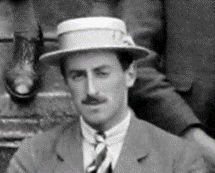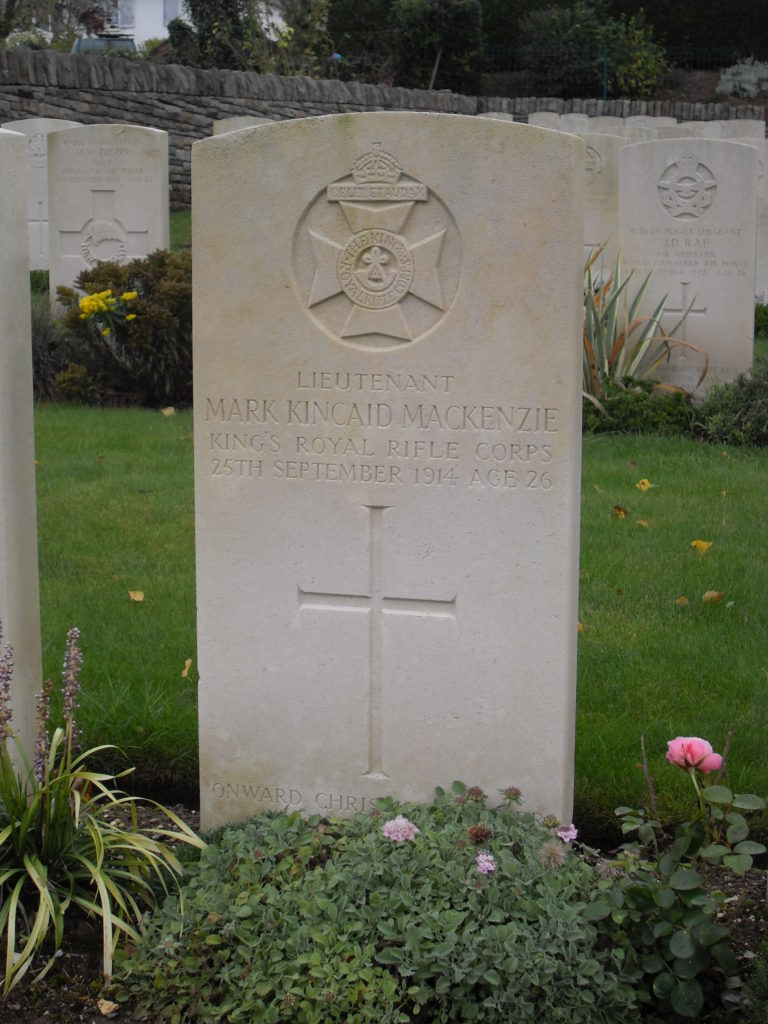Fact file:
Matriculated: 1907
Born: 22 August 1888
Died: 25 September 1914
Regiment: King’s Royal Rifle Corps attached to Rifle Brigade
Grave/Memorial: Montcornet Military Cemetery: H.6
Family Background
b. 22 August 1888 at 54 Northumberland St, New Town, Edinburgh, Midlothian, as the only child of the Hon. Lord Charles Kincaid Mackenzie LLD (1857–1938) and Lady Lilias (Lily) Mackenzie (née Young) (c. 1853–1945) (m. 1881). By the time of the 1891 Census the family was living at 47 Heriot Row, Edinburgh (three servants).
Mackenzie’s father was an eminent Scottish jurist who began his distinguished career as an advocate: Advocate Depute (1890–96), Senior Advocate Depute (1896–1901), Counsel to the Board of Trade (1892–1900). He then became the Sheriff-Principal of Fife and Kinross (1901–05), a Lord of Session on the Bench of the Supreme Civil Court of Scotland (1905–22), and Chairman of the Committee of Criminal Appeal in Scotland (1925). In both 1895 and 1900 he stood, unsuccessfully, as Unionist candidate for Mid Lanark and from 1908 to 1922 he was a Railway Commissioner. Mackenzie’s mother was the daughter of Lord Young, PC (1819–1907), a Scottish Liberal MP and then a famous Scottish judge.
Education
Mackenzie attended Horris Hill Preparatory School (also known as Mr Evans’s Preparatory School), Hampshire [founded 1888; cf. Guy Bonham-Carter, Geoffrey Hugh Alington, Philip Algernon Tillard, Ralph Hugh Hine-Haycock, Henry Farr Yeatman] from c.1895 to 1901, and then nearby Winchester from 1901 to 1907. At Winchester, where he was in ‘H’ House, he was a House Prefect, a member of the Commoner XV in 1905, a member of the Commoner VI (Winchester’s particular brand of six-aside football known as “our game”) in 1906 and a member of the Golf Club Committee 1906–07. In summer 1906 he played in the annual cricket match against Eton and took three wickets: he would have taken more had he not injured his leg at the start of the match. He also played for Winchester against the MCC at Lords’ 1905–7 and was the team’s Second Captain 1906–07: “Accurate left-hand medium-pace bowler, who with more variety would be really good. Could always be relied upon to keep up an end. Much improved bat and field”. He matriculated at Magdalen as a Commoner on 15 October 1907, having taken Responsions in Hilary Term 1907. He took the First Public Examination in Trinity Term and September 1908 and then, from Trinity Term 1909 to Hilary Term 1910, read for a Pass Degree (Groups A1 [Greek and/or Latin Literature/Philosophy], E1 [The Elements of Military History and Strategy], and E2 [Tactics, Map Reading and Field Sketching, Field Engineering]. He took his BA on 13 October 1910. While at Oxford, MacKenzie, like his father, continued his enthusiasm for sport. He played cricket for the University and was particularly successful as a left-hand bowler; he also played golf to the same level and was a member of I Zingari and The Harlequins. In 1909 he was a member of the College’s First XI, six members of which (MacKenzie himself, George Bruce Gilroy, Henry Maurice Watkin Wells, the two Cattley brothers (Cyril Francis and Gerald Wildman) and Isaac Bayley Balfour) would be killed in action.
Military and war service
Mackenzie joined the Oxford University Volunteer Rifle Corps during his first term at Magdalen, in 1907, and became a Second Lieutenant on probation (university candidate) on 5 November 1909. After graduation, he began his military career as a Regular officer by joining the East Lancashire Regiment, from which he was transferred to the 4th (Regular) Battalion, the King’s Royal RifleCorps, on 5 July 1911. He was then attached to the 3rd (Regular) Battalion, the Rifle Brigade (The Prince Consort’s Own), probably when it was serving in India, and finally promoted Lieutenant on 3 March 1914. By the time that war broke out, the 3rd Battalion was garrisoned in Cork, but was transferred to Cambridge by 18 August, where it trained until 8 September as part of the 17th Infantry Brigade, 6th Division. The Battalion disembarked at St Nazaire on 14 September, entrained, and arrived at Coulommiers, to the east of Paris, at 02.00 hours on the following day, during the opening hours of the Battle of the Aisne. It then marched north-westwards towards the River Aisne via St Cyr-sur-Morin and Château-Thierry, reached the village of Villeblain, south of Soissons, on 16 September after a 30-mile march, rested there for three days, and then proceeded to Courcelles-sur-Vesles (see Gladwyn Maurice Revell Turbutt). On 21 September the Battalion took over from the 1st Battalion, The Berkshire Regt at the Ferme du Metz, in the village of Braye-en-Laonnois, on the right of the British line. The farm was situated just to the north of the Canal de l’Oise à l’Aisne (which now runs north-west/south-east along the D887) and is about three miles north of Soupir, where the British trenches were 290 yards from the German ones.

The Ferme du Metz (now completely destroyed, Braye-en-Laonnois). One of the locks on the Canal de l’Oise à l’Aisne is visible in the foreground.
The Battalion saw its first action on the following day, but three days later, at dawn on 25 September 1914, Mackenzie’s ‘C’ and part of ‘D’ Company – a total of about 50 men commanded by Major Anthony Drummond Boden (1872–1914; no known grave) – charged the German trenches with fixed bayonets. But the Germans turned out to be more numerous than had been expected and the attackers were soon pinned down by machine-gun fire. Mackenzie was wounded during this attack, got up, and continued to call out “Come on, Come on” until he was killed in action close to the enemy trenches, aged 26. At first, the ground was too exposed for stretcher-bearers to be sent out, but his body, together with those of seven of his men, was eventually recovered and buried in the village of Braye-en-Laonnois. Each was provided with a wooden cross, but by 27 June 1936 those markers had disappeared, and when, on that day, the bodies were exhumed, only about half of them could be identified by means of dental work and personal effects. All seven are now buried in Montcornet Military Cemetery (north-east of Laon and 28 miles north-east of Soupir), where the bodies of many men who lay in isolated graves were concentrated between the wars. Mackenzie’s remains are in Grave H.6 and those of his seven comrades in Graves H.7 to H.13; Mackenzie’s headstone is inscribed “Onward Christian Soldier”. For over a year, Lord Mackenzie made extensive and painstaking enquiries concerning the circumstances surrounding his son’s death and finally sent his findings to the War Office on 23 January 1916. Mackenzie left £7,450 16s. 10d.
Bibliography
For the books and archives referred to here in short form, refer to the Slow Dusk Bibliography and Archival Sources.
Printed sources:
[Anon.], [untitled obituary], The Times, no. 40,661 (10 October 1914), p. 10.
Rendall, ii (1921), p. 122 (photo).
Berkeley and Seymour, i (1927), pp. 27–9.
[Anon.], ‘Lord Mackenzie’ [obituary], The Times, no. 47,960 (4 April 1938), p. 16.
Leinster-Mackay (1984), pp. 107, 113, 139.
Archival sources:
MCA: Ms. 876 (III), vol. 2.
OUA: UR 2/1/63.
WO95/1613.
WO339/7826.




